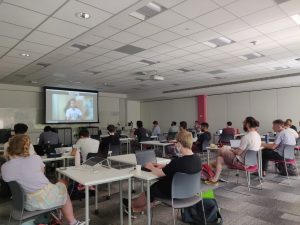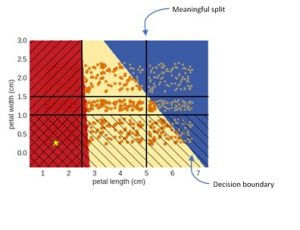This review of the 4th day of the BIAS event, ‘Data-Driven AI’, is written by CDT Student Stoil Ganev.
The main focus for the final day of BIAS was Data-Driven AI. Out of the 4 pillars of the Interactive AI CDT, the Data-Driven aspect tends to have a more “applied” flavour compared to the rest. This is due to a variety of reasons but most of them can be summed up in the statement that Data-Driven AI is the AI of the present. Most deployed AI algorithms and systems are structured around the idea of data X going in and prediction Y coming out. This paradigm is popular because it easily fits into modern computer system architectures. For all of their complexity, modern at-scale computer systems generally function like data pipelines. One part takes in a portion of data, transforms it and passes it on to another part of the system to perform its own type of transformation. We can see that, in this kind of architecture, a simple “X goes in, Y comes out” AI is easy to integrate, since it will be no different from any other component. Additionally, data is a resource that most organisations have in abundance. Every sensor reading, user interaction or system to system communication can be easily tracked, recorded and compiled into usable chunks of data. In fact, for accountability and transparency reasons, organisations are often required to record and track a lot of this data. As a result, most organisations are left with massive repositories of data, which they are not able to fully utilise. This is why Data-Driven AI is often relied on as a straight forward, low cost solution for capitalising on these massive stores of data. This “applied” aspect of Data-Driven AI was very much present in the talks given at the last day of BIAS. Compared to the other days, the talks of the final day reflected some practical considerations in regards to AI.

The first talk was given by Professor Robert Jenssen from The Arctic University of Norway. It focused on work he had done with his students on automated monitoring of electrical power lines. More specifically how to utilise unmanned aerial vehicles (UAVs) to automatically discover anomalies in the power grid. A point he made in the talk was that the amount of time they spent on engineering efforts was several times larger than the amount spent on novel research. There was no off the shelf product they could use or adapt, so their system had to be written mostly from scratch. In general, this seems to be a pattern with AI systems where even, if the same model is utilised, the resulting system ends up extremely tailored to its own problem and cannot be easily reused for a different problem. They ran into a similar problem with the data set, as well. Given that the problem of monitoring power lines is rather niche, there was no directly applicable data set they could rely on. I found their solution to this problem to be quite clever in its simplicity. Since gathering real world data is rather difficult, they opted to simulate their data set. They used 3D modelling software to replicate the environment of the power lines. Given that most power masts sit in the middle of fields, that environment is easy to simulate. For more complicated problems such as autonomous driving, this simulation approach is not feasible. It is impossible to properly simulate human behaviour, which the AI would need to model, and there is a large variety in urban settings as well. However, for a mast sitting in a field, you can capture most of the variety by changing the texture of the ground. Additionally, this approach has advantages over real world data as well. There are types of anomalies that are so rare that they might simply not be captured by the data gathering process or be too rare for the model to notice them. However, in simulation, it is easy to introduce any type of anomaly and ensure it has proper representation in the data set. In terms of the architecture of the system, they opted to structure it as a pipeline of sub-tasks. There are separate models for component detection, anomaly detection, etc. This piecewise approach is very sensible given that most anomalies are most likely independent of each other. Additionally, the more specific a problem is, the easier and faster it is to train a model for it. However, this approach tends to have larger engineering overheads. Due to the larger amount of components, proper communication and synchronisation between them needs to be ensured and is not a given. Also, depending on the length of the pipeline, it might become difficult to ensure that it perform fast enough. In general I think that the work Professor Jenssen and his students did in this project is very much representative of what deploying AI systems in the real world is like. Often your problem is so niche that there are no readily available solutions or data sets, so a majority of the work has to be done from scratch. Additionally, even if there is limited or even no need for novel AI research, a problem might still require large amounts of engineering efforts to solve.
The second talk of the day was given by Jonas Pfeiffer, a PhD student from the Technical University of Darmstadt. In this talk he introduced us to his research on Adapters for Transformer models. Adapters are a light weight and faster approach to fine tuning Transformer models to different tasks. The idea is rather simple, the Adapters are small layers that are added between the Transformer layers, which are trained during fine tuning, while keeping the transformer layers fixed. While pretty simple and straight forward, this approach appears to be rather effective. However, other than focusing on his research on Adapters, Jonas is also one of the main contributors to AdapterHub.ml, a framework for training and sharing Adapters. This brings our focus to an important part of what is necessary to get AI research out of the papers and into the real world – creating accessible and easy to use programming libraries. We as researchers often neglect this step or consider it to be beyond our responsibilities. That is not without sensible reasons. A programming library is not just the code it contains. It requires training materials for new users, tracking of bugs and feature requests, maintaining and following a development road map, managing integrations with other libraries that are dependencies or dependers, etc. All of these aspects require significant efforts by the maintainers of the library. Efforts that do not contribute to research output and consequently do not contribute to the criteria by which we are judged as successful scientists. As such, it is always a delight when you see a researcher willing to go this extra mile, to make his or her research more accessible. The talk by Jonas also had a tutorial section where he led us though the process of fine tuning an off the shelf pre-trained Transformer. This tutorial was delivered through Jupyter notebooks easily accessible from the projects website. Within minutes we had our own working examples, for us to dissect and experiment with. Given that Adapters and the AdapterHub.ml framework are very recent innovations, the amount and the quality of documentation and training resources within this project is highly impressive. Adapters and the AdapterHub.ml framework are excellent tools that, I believe, will be useful to me in the future. As such, I am very pleased to have attended this talk and to have discovered these tools though it.
The final day of BIAS was an excellent wrap up to the summer school. With its more applied focus, it showed us how the research we are conducting can be translated to the real world and how it can have an impact. We got a flavour of both, what it is like to develop and deploy an AI system, and what it is like to provide a programming library for our developed methods. These are all aspects of our research that we often neglect or overlook. Thus, this day served as great reminder that our research is not something confined within a lab but that it is work that lives and breathes within the context of the world that surrounds us.


